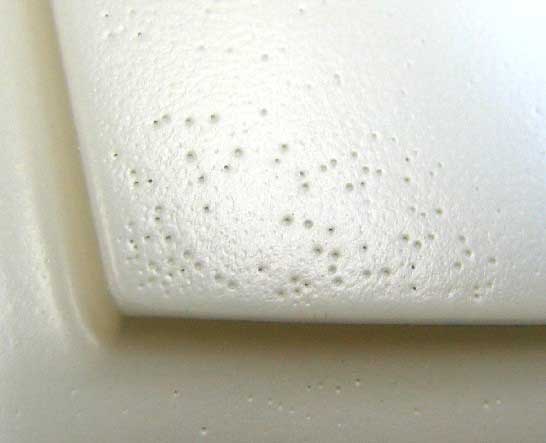Pinholes: Causes and Cures
A finisher reports pinholes in the topcoat, and learns about what may be causing them. June 28, 2005
Question
I have had a problem dealing with pinholes in the topcoat for some time now. I use S.W. H.S. Vinyl Sealer and S.W. C.V. spraying with a Kremlin Airmix 10.14 pump. The pinholes show up as soon as I spray, but do go away somewhat after it lies down. It only happens on plywood, and there is no problem with the hardwood. One sealer and one topcoat is what I’ve been using. If I sand the topcoat and apply another, the pinholes are non-existent. I use many different wood species, but maple and cherry are used the most. Any help would be appreciated.
Forum Responses
(Finishing Forum)
From contributor M:
Do you have a moisture meter to check the plywood’s MC? This is one of many causes for pinholes.
From contributor R:
Is it cold where you are spraying? Could these pinholes be micro bubbles? If your finish (or the substrate for that matter) is too cold, the viscosity thickens which makes it difficult for it to flow out properly. When it dries, these bubbles will look like small groupings of pinholes.
From contributor M:
Here is a second cause that could be happening. After the first and second coat are applied, the third coat follows too fast. This slows down the gas in the slower solvents and let’s it rise and then exit the coating. The tiny bubbles are then slowed down by the next coating, and they are them trapped in-between the coatings.
The temperature in the shop definitely can be a part of causing this to occur. Try allowing a little more time before you apply each coat, so the slower solvents can exit. And try not to make double passes.
From Paul Snyder, forum technical advisor:
Pinholes/solvent pop is often caused by applying the finish too heavy. It's easy to do with a pump; the Kremlin puts out a lot of fluid very quickly. The finish skins over before the solvents have off-gassed, and they leave a pit when they break through the skin.
Other possible causes include water in the air-line, or air trapped in the pores on large pored wood like oak or ash.To avoid solvent pop, thin the finish a little and add a little retarder. As a part of your normal daily routine, drain your water-trap and compressor tank. If you're working with large pored wood, start with a coat of thinned finish/sealer to stop up the pores.

Click here for full size image
From contributor D:
It’s probably solvent gas trying to escape. I would suggest trying to retard your material a little to give the gases time to escape before the exterior begins to film. You can see these tiny gas bubbles dancing in the finish as it is drying.
From contributor M:
Here is a simple test to see the "gas" bubbles as they are escaping. Take a panel, spray out your coating, and then lift the panel up closer to you and watch the bubbles escaping up through the coating - doing this will allow the bubbles to fully escape. I doubt if you will ever see pinholes, unless there is moisture in your woods, compressor, airlines, solvents, or coatings.
From contributor P:
I recently had a similar problem. I sprayed a water-based poly over an oil based glaze that had three days to dry. After spraying the first coat, you could randomly see small groups of pinholes that were barely noticeable when dry. Actually the lighter I sprayed, the more prevalent they were, and the second coat got rid of them. I thought that it might be the surface tension that the oil glaze created with the water poly on top. I did not try thinning the first coat, but that sounds like it might have helped.
From the original questioner:
Thanks for the suggestions. I’m based in Florida, so moisture in the plywood sounds about right. We have two spray booths, both are heated, and we have a dryer on our compressor and oil and water filters on the lines going to the booths. I sometimes try spraying a tack coat first, then a standard coat thinking it was the gasses, but the pinholes were still there. I have also tried retarding the material with the same results. If it is moisture in the wood what is my next step?
From contributor M:
To the original questioner: I would suggest talking with your wood supplier, and getting a moisture meter so you can verify the moisture content in the woods you are buying.
